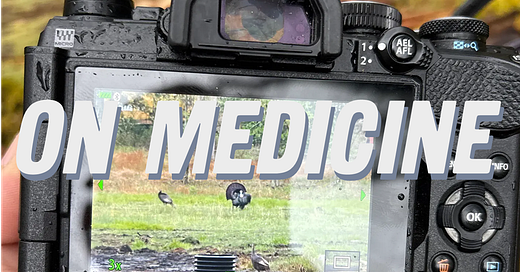A wild turkey has a fantastic luminosity, an indescribable iridescence of blues and reds and whites brought out in the spring, the Toms hot-headed and hot-blooded, gobbling and drumming and strutting and full of vigor and vitality. Their heads — and it’s their heads where this is most evident — are radiant and glowing and then after you kill one that luster seeps away, their eyes clouding, their vibrancy dripping back into the Earth.
You have just a few breaths to watch this all happen, that spirit passing through you. It’s the same way when you catch but don’t release a fish, the rainbow of shimmering color fading back into the water, life slipping away with shuddering gills. A lifetime and a second of vigor and then a heavy stillness filling the body, shrouding the eyes.1
I sent my friend
an early draft of the essay I published last month about my shift as a writer, and when I told him it wasn’t being published for another two weeks he remarked that delayed, it would lose some of its power. That I’d harnessed some sort of energy in the piece and that by the time it was read, that magic would fade, same as with a turkey, same as with a trout.Many Plains Indians believed a person or a place or an object could harbor “medicine.” That you could bring this power into the world, stopping bullets with naught but courage, your energy — your life force — functioning as armor.2 Animals have strong medicine — of this I’m sure — but can writing have it, too?
What happens when writing acts as a conduit, setting in permanence a fleeting transmission? Does an essay work like a tintype, capturing the moment but spilling the medicine? Can it even be preserved, or is it more like catching lightning in a bottle — illuminating, but quickly losing charge?3 Zeno thought about this, indirectly, when he pondered over his arrow. Is the story composed of instants, always and never moving? How do you catch an arrow in flight?4
I’m writing this a week before my turkey season opens, hoping to catch that magic and experience the radiance first hand. When — if — I go to write about it, will that spark still be there?
At the very least, I believe there is value in reciting the story around the campfire — not to preserve it, really, but to imbue it with new life.5
I wrote this, appropriately, a few weeks ago. Since the season has opened, I’ve been out a handful of times, gotten on birds, not gotten on birds, gotten a shot off at a bird — but still haven’t connected to see that iridescence fade. We’re now halfway through the season and I’m still trying to conjure the magic. Who would have thought trying to talk sexy to a twenty-pound bird could be so difficult, so exciting?
While waiting for a gobbler, we’re back to raiding the freezer for meals. Coming off an extended stay on the Vineyard — where seafood predominated the menu — we’re working through some of the pork cuts from our meat CSA to keep our meals grounded. With that in mind, here’s our “can’t miss”6 recipe for pork chops, paired with hot, buttered radishes — the first from the garden.
Pre-heat your oven to 375(F). Using the thickest cut porkchops from an heirloom pig that you can find, liberally season them with salt and pepper (or your favorite pre-made spice blend). Get a cast iron pan ripping hot, and sear each side for two to three minutes, until the pork develops a nice crust. Remove the pan to the oven and cook for 9-15 minutes, depending on thickness and desired doneness.
While the pork is finishing, bring another pan to hot and add a hunk of butter. Saute quickly fresh, small radishes — with their leaves still on and salted — until they are slightly softened and the greens begin to crisp. Serve all of this with the chops and whatever other sides you’d like to enjoy.
So there you go, folks — seared and roasted pork chops. If we’re being honest, though, these radishes always steal the show. If you can, give them a shot.7
A quiet weekend on the ranch for us: we’re really just prepping for next weekend, Memorial Day, my favorite holiday8, and a jaunt up north.9 So we bide our time, getting some vegetables in the ground, soaking in some sunlight, inevitably eating dirt. In these ways we brace ourselves for summer.
We’ll see you back here next week.
I’ve heard the best way to determine the freshness of a fish at the market is by the residual gleam in its eye.
It’s also no surprise that the idea that consuming something — an animal, a plant, something more macabre — will allow you to absorb its life force or energy is so prevalent across cultures.
And, in a format like a weekly essay, what happens when — like in this instance — the writer drafts a note that isn’t read for days or weeks? Can the spark fade if the reader doesn’t know when it was lit or is it lit anew each first time it’s found?
Asking for a turkey.
“It’s all in your imagination — until it isn’t.”
If only that invocation worked while hunting.
It’s perhaps — but almost certainly not — coincidence that the Latin root for radical is radix which itself means root and also brings us radish. I’ve said it before: Everything is connected.
Or at least in the pantheon, as I’ve written ad naseum.
Along with Sam, who can give me grief for preempting any magic by writing about it now.








But don’t hold your breath.
For the writer, the energy fades upon completion. For each new reader, essays are evergreen.
Radishes? Didn't see that one coming!